Volkswagen Tiguan Service and Repair Manual: Refrigerant Circuit, Detecting Leaks
Searching for Refrigerant Circuit Leaks with Compressed Air or Nitrogen
Note
- This repair manual describes different methods for detecting leaks in the refrigerant circuit. These methods have been tested and result in success when used correctly.
- If when searching for compressed air / Nitrogen or vacuum leaks none are found, add a leak detection additive i.e UV leak detection additive, to the electric leak detecting unit.
- Minor leaks can be detected using an electronic leak detector or UV leak detector lamp.
- Many methods for detecting leaks in the refrigerant circuit are offered in the open market. These methods do not always have optimum results. If they are not used exactly according to specifications, they can indicate refrigerant circuit components have leaks even when they do not. Also, refrigerant circuit components can be damaged by some methods.
- Do not repair components with leaks. Replace them with new original parts.
- Do not charge a leaking refrigerant circuit with refrigerant. Evacuate the circuit and check it for leaks before charging.
Caution
- If it is suspected that chemicals were added to the refrigerant circuit to seal leaks, do not connect the A/C service station and do not extract the refrigerant.
- Chemicals that seal leaks in the coolant circuit form deposits that affect the function of the A/C system and lead to failure of the A/C system and the A/C service station.
- Inform that customer that there are substances in the A/C system that are no approved by Volkswagen. This A/C system cannot be drained or serviced in the workshop.
Note
- VW does not approve the use of chemicals to seal leaks in the refrigerant circuit.
- Chemicals used to seal leaks in the refrigerant circuit often react with air and the moisture in it. They cause deposits in the refrigerant circuit and the A/C service station and malfunctions in valves and other components that they come in contact with. These deposits cannot be removed completely from the components, even by flushing.
- Chemicals used to seal leaks in the refrigerant circuit usually cannot be detected from outside. The label that should be applied to identify it is often missing. Therefore be careful when working with if you do not know its service history.
- Accessories offer containers used to separate out these chemicals (used to seal leaks in the refrigerant circuit). Because VW does not approve the use of these chemicals, there is no evidence of the effectiveness of these filters.
Note
- A leak can be identified if a maximum of pressure of 15 bar (218 psi) can be generated in the refrigerant circuit using clean, dry compressed air or nitrogen. If the leak is large enough, the sound of escaping air or gas can be heard at the location of the leak.
- Use the service connection for the compressed air or nitrogen.
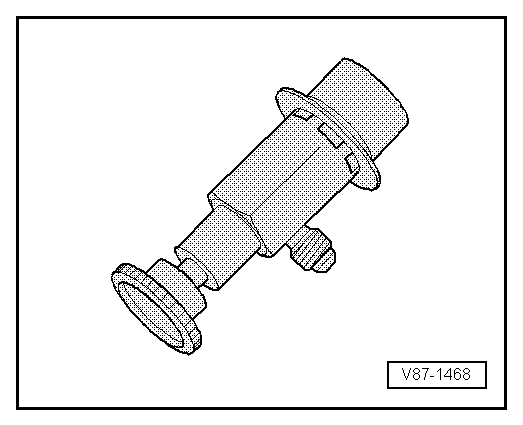
- The quick-release coupling adapter for service connections can be connected to the air compressor using a modified filler hose -A- (for example, with 5/8" 18 UNF threads, different from the threads on the quick-release coupling adapter) and a suitable adapter -B-. This keeps humidity, oil and dirt coming out of the workshop compressed air system from getting into the A/C refrigerant circuit. Also use a combination fine-gauge filter for compressed air systems such as those that are standard in paint shops. Install it between the compressed air system and the filler hose -A- . Refer to the Special Tools and Equipment Catalog.
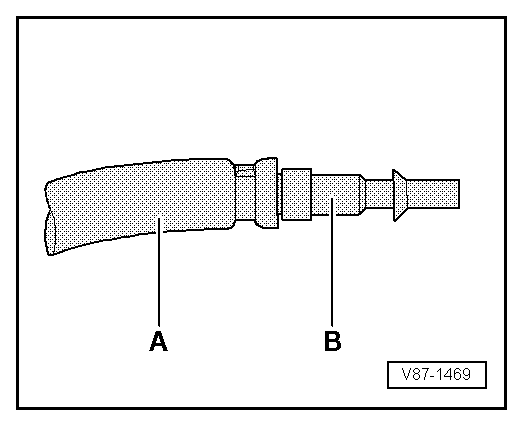
- A compressed gas cylinder filled with nitrogen -3- can be connected to the closed refrigerant circuit using a pressure gauge battery with a pressure reducer for nitrogen (maximum reduction pressure: 15 bar (218 psi) ) -1- and a filler hose -2- (for example, with 5/8" 18 UNF threads) connected to the service connection. A quick-release coupling adapter must also be connected to the service connection.
WARNING
- The maximum permitted working pressure is 15 bar (218 psi).
- When testing for leaks with nitrogen, always work with a pressure reducer for nitrogen bottles.
- Find the location of the leak by listening for the sound of venting gas. An Ultrasonic Tester VAG1842S -VAG1842S- will aid in detecting the origin of noise.
- Use clean, dry compressed air to force the nitrogen out of the refrigerant circuit. The nitrogen must not get into the Service bottle. Reason: gases that do not condense do not get into the Service bottle.
- Repair the leak.
- Evacuate and again observe the vacuum display over a period of hours. Only when the vacuum is maintained can the refrigerant circuit be charged.
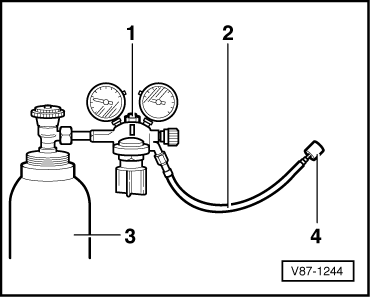
- If there is a leak that is small enough that no air or very little air vents through it and the A/C service station can generate a sufficient vacuum. The vacuum indicator does not increase after switching the A/C system service station or only increases slowly, indicating that air is only entering through a small leak.
- Add 100 grams of refrigerant to the circuit, find the location of the leak using an electronic leak detector and repair it or add UV contrast dye to the refrigerant and find the location of the leak with the leak detection system VAS6201 or succeeding model and repair it.
- Empty the refrigerant circuit, if necessary.
- Evacuate and check the vacuum display again over several hours. Only when the vacuum is maintained can the refrigerant circuit be charged.
Refrigerant Circuit, Tracing Leaks, with Electronic Leak Detector -VAG1796-
Note
- This repair manual describes different methods for detecting leaks in the refrigerant circuit. These methods have been tested and result in success when used correctly.
- If when searching for compressed air / Nitrogen or vacuum leaks none are found, add a leak detection additive i.e UV leak detection additive, to the electric leak detecting unit.
- Minor leaks can be detected using an electronic leak detector or UV leak detector lamp.
- Many methods for detecting leaks in the refrigerant circuit are offered in the open market. These methods do not always have optimum results. If they are not used exactly according to specifications, they can indicate refrigerant circuit components have leaks even when they do not. Also, refrigerant circuit components can be damaged by some methods.
- Do not repair components with leaks. Replace them with new original parts.
- Do not charge a leaking refrigerant circuit with refrigerant. Evacuate the circuit and check it for leaks before charging.
Caution
- If it is suspected that chemicals were added to the refrigerant circuit to seal leaks, do not connect the A/C service station and do not extract the refrigerant.
- Chemicals that seal leaks in the coolant circuit form deposits that affect the function of the A/C system and lead to failure of the A/C system and the A/C service station.
- Inform that customer that there are substances in the A/C system that are no approved by Volkswagen. This A/C system cannot be drained or serviced in the workshop.
Note
- VW does not approve the use of chemicals to seal leaks in the refrigerant circuit.
- Chemicals used to seal leaks in the refrigerant circuit often react with air and the moisture in it. They cause deposits in the refrigerant circuit and the A/C service station and malfunctions in valves and other components that they come in contact with. These deposits cannot be removed completely from the components, even by flushing.
- Chemicals used to seal leaks in the refrigerant circuit usually cannot be detected from outside. The label that should be applied to identify it is often missing. Therefore be careful when working with if you do not know its service history.
- Accessories offer containers used to separate out these chemicals (used to seal leaks in the refrigerant circuit). Because VW does not approve the use of these chemicals, there is no evidence of the effectiveness of these filters.
Note
Minor leaks can be detected using an electronic leak detector for example.
- Discharge the refrigerant circuit with the A/C service station.
Note
- Be ready to evacuate a large leak should one be found.
- If no leak is found during evacuation or there is a leak that is so small that the location cannot be found, proceed as follows.
- Currents of air quickly disperse refrigerant gas. Draughts must therefore be avoided during leak detection.
- If the refrigerant circuit is completely empty, fill with refrigerant to approximately 10% of the fill capacity (R134a label or vehicle-specific Repair Manual).
Leak detection:
- Start up leak detector in line with relevant operating instructions.
- Always hold test probe beneath suspected leak.
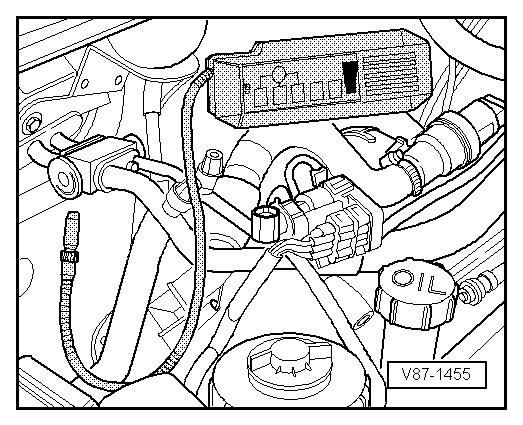
Depending on the model, leak detection is indicated by an increase in clicking rate or a warning tone. Refer to operating instructions for leak detector.
Refrigerant Circuit, Tracing Leaks, with Leak Detection System -VAS6196- or Leak Detection Kit -VAS6201A- or Succeeding Model
Note
- This repair manual describes different methods for detecting leaks in the refrigerant circuit. These methods have been tested and result in success when used correctly.
- If when searching for compressed air / Nitrogen or vacuum leaks none are found, add a leak detection additive i.e UV leak detection additive, to the electric leak detecting unit.
- Minor leaks can be detected using an electronic leak detector or UV leak detector lamp.
- Many methods for detecting leaks in the refrigerant circuit are offered in the open market. These methods do not always have optimum results. If they are not used exactly according to specifications, they can indicate refrigerant circuit components have leaks even when they do not. Also, refrigerant circuit components can be damaged by some methods.
- Do not repair components with leaks. Replace them with new original parts.
- Do not charge a leaking refrigerant circuit with refrigerant. Evacuate the circuit and check it for leaks before charging.
Caution
- If it is suspected that chemicals were added to the refrigerant circuit to seal leaks, do not connect the A/C service station and do not extract the refrigerant.
- Chemicals that seal leaks in the coolant circuit form deposits that affect the function of the A/C system and lead to failure of the A/C system and the A/C service station.
- Inform that customer that there are substances in the A/C system that are no approved by Volkswagen. This A/C system cannot be drained or serviced in the workshop.
Note
- VW does not approve the use of chemicals to seal leaks in the refrigerant circuit.
- Chemicals used to seal leaks in the refrigerant circuit often react with air and the moisture in it. They cause deposits in the refrigerant circuit and the A/C service station and malfunctions in valves and other components that they come in contact with. These deposits cannot be removed completely from the components, even by flushing.
- Chemicals used to seal leaks in the refrigerant circuit usually cannot be detected from outside. The label that should be applied to identify it is often missing. Therefore be careful when working with if you do not know its service history.
- Accessories offer containers used to separate out these chemicals (used to seal leaks in the refrigerant circuit). Because VW does not approve the use of these chemicals, there is no evidence of the effectiveness of these filters.
Note
Small leaks can be detected using a UV-leak detection additive for example.
- Discharge the refrigerant circuit with the A/C service station.
Note
- Be ready to evacuate a large leak should one be found.
- If no leak is found during evacuation or there is a leak that is so small that the location cannot be found, proceed as follows.
- Currents of air quickly disperse refrigerant gas. Draughts must therefore be avoided during leak detection.
- If the refrigerant circuit is completely empty, fill with refrigerant to approximately 10% of the fill capacity (R134a label or vehicle-specific Repair Manual).
Leak Detection System -VAS6196-
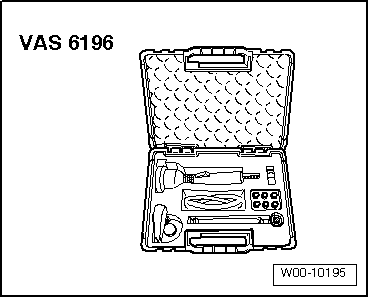
Leak Detection System -VAS6201- or succeeding model
- Leak Detection Kit - Hand Pump w/Cartridge -VAS6201/1-
- Leak Detection Kit - Cartridge -VAS6201/2-
- Leak Detection Kit - Cleaning Solution -VAS6201/3-
- UV Leak Detection Lamp -VAS6201/4A-
- Leak Detection Kit - Eye Protection -VAS6201/6-
- Leak Detection Kit - Label -VAS6201/7-
- Tube -VAS6201/8-
- Leak Detection Kit - Hand Protection -VAS6201/9-
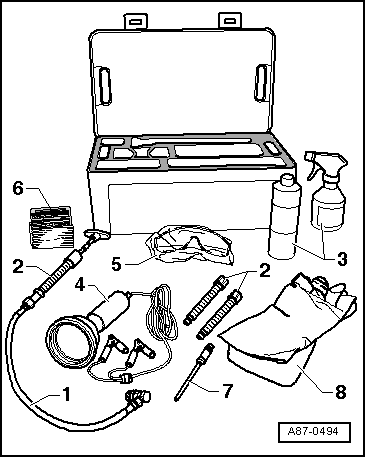
Filling with leak detection additive when the refrigerant circuit is empty
The cartridge -A- contains 15.4 ml of leak detection additive (one unit -B- corresponds to 2.5 ml).
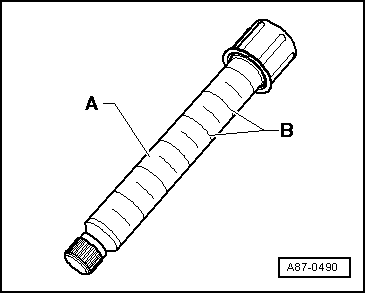
- Assemble the Leak Detection Kit -VAS6201A--1- with the cartridge -2-Leak Detection Kit - Cartridge -VAS6201/2-.
- Insert the Leak Detection Kit - Filler Tube -VAS6201/8- into the hand pump.
- Open the hand pump service valve.
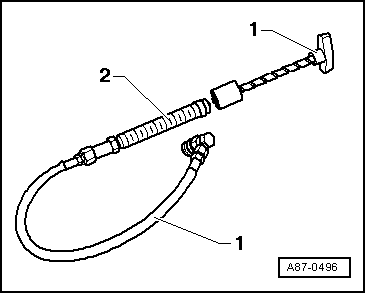
Leak detection additive is best added to empty refrigerant circuit via opened connection.
- Open an easily accessible connection point on refrigerant circuit
- Cover area around connection point with foil or absorbent paper.
- Hold tube upwards.
- Tighten the toggle on the hand pump until the leak detection additive comes out of the tube.
- Add 2.5 +- 0.5 ml (milliliter = cm3) of leak detection additive to the refrigerant circuit.
Note
If leak detection additive was already added to the refrigerant circuit for an earlier repair, note the following: Only add new leak detection additive if the refrigerant oil will be replaced. If only a portion of the refrigerant oil was replaced, only add a proportionate amount of the leak detection additive. For example, if 100 ml of refrigerant oil was replaced in a vehicle with 250 ml, add only 1 ml (cm3) of leak detection additive.
- Replace the O-rings on opened connection point.
- Assemble refrigerant circuit
- Apply a label near the service connection stating that leak detection additive was added to the refrigerant circuit.
- Evacuate and recharge refrigerant circuit according to specification.
- Start the A/C system.
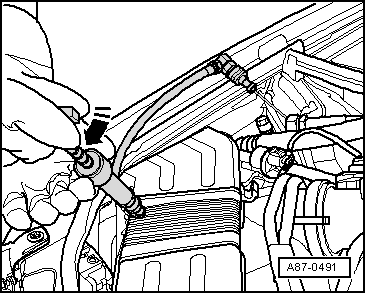
Note
The A/C system must run for at least 60 minutes so the additive distributes itself through the entire refrigerant circuit. The compressor must be running. Depending on the size of the leak, it may become visible within that time.
- Find the leak in the refrigerant circuit with the UV lamp VAS6196/4.
Note
Remove existing leak detection additive in the engine compartment or from the refrigerant circuit components using Leak Detection Kit - Cleaning Solution -VAS6201/3-.
Leak detection additive with filled refrigerant circuit, filling
Note
- If leak detection additive was already added to the refrigerant circuit for an earlier repair, note the following: Only add new leak detection additive if the refrigerant oil will be replaced. If only a portion of the refrigerant oil was replaced, only add a proportionate amount of the leak detection additive. For example, if 100 ml of refrigerant oil was replaced in a vehicle with 250 ml, add only 1 ml (cm3) of leak detection additive.
- A small quantity of leak detection additive remains in the service connection. Carefully remove this residual amount so a leaking area is not detected erroneously upon a later leak detection.
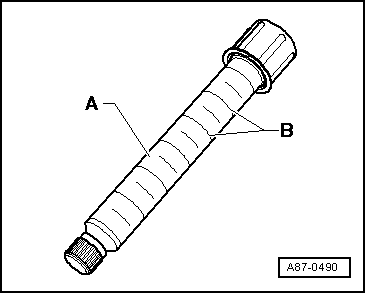
The cartridge -A- contains 15.4 ml of leak detection additive (one unit -B- corresponds to 2.5 ml).
- Switch off ignition.
- Remove sealing cap from service connection of low pressure side in refrigerant circuit.
- Assemble the Leak Detection Kit -VAS6201A--1- with the cartridge -2-Leak Detection Kit - Cartridge -VAS6201/2-.
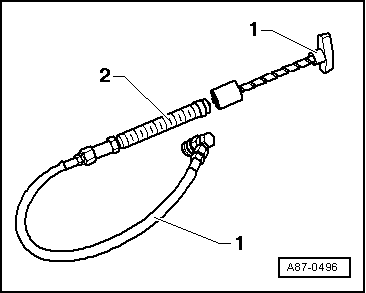
Note
Make sure the hand pump hose is completely filled with leak detection additive.
- Place the quick-release coupling on the low pressure side service connection and tighten the hand wheel to open the service coupling. Hold the hose upward and tighten the handle of the hand pump just enough until the leak detection additive starts to emerge from the tube.
- Cover area around service connection on vehicle with foil or absorbent paper.
- Tighten the toggle on the hand pump to add 2.5 +- 0.5 ml (milliliter = cm3) of leak detection additive to the refrigerant circuit.
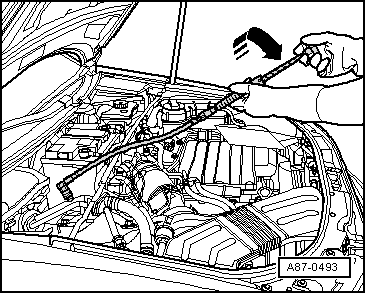
- Close the service coupling and remove it from the service connection.
- Remove the rest of the leak detection additive from the service connection, for example with absorbent paper.
- Seal service connection with sealing cap.
- If necessary, clean area around service connection using cleaning agents.
- Place a label next to the service connection stating that leak detection additive was added to the refrigerant circuit.
- Start the A/C system.
Note
The A/C system must run for at least 60 minutes so the additive distributes itself through the entire refrigerant circuit. The compressor must be running. Depending on the size of the leak, it may become visible within that time.
- Find the leak in the refrigerant circuit with the UV lamp VAS6196/4.
Note
Remove existing leak detection additive in the engine compartment or from the refrigerant circuit components using Leak Detection Kit - Cleaning Solution -VAS6201/3-.
Detecting leaks in the refrigerant circuit using the UV Lamp VAS6196/4
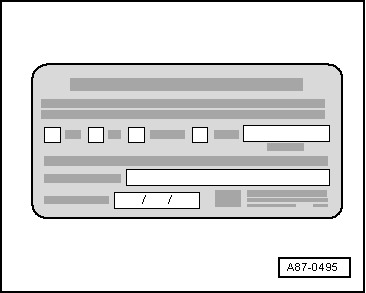
WARNING
Do not look into the UV lamp.
Do not direct UV lamp at other people.
Note
- The A/C system must run for at least 60 minutes so the additive distributes itself through the entire refrigerant circuit. The compressor must be running. Depending on the size of the leak, it may become visible within that time.
- With leaks on evaporator, leak detection additive is possibly washed off with condensation and flows out via evaporator drain. Since the evaporator is not easily accessible on most vehicles, checking the evaporator drain may indicate if the evaporator is leaking. However, it is necessary for this purpose that leak detection additive has already been in the refrigerant circuit for a long period of time.
- Protective goggles do not only serve as eye protection but also amplify the illumination of leak detection additive under UV light.
- Depending on the accessibility of different components in the refrigerant circuit, it may be necessary to remove some vehicle components such as the bumper or air filter.
- Move vehicle into a slightly darker area of the workshop (with daylight or bright lighting the effect of the UV light is diminished).
- Check the accessibility of the various components in the refrigerant circuit and remove any components in the area that block access to the refrigerant circuit such as noise insulation and the bumper.
- Wear protective eyewear to protect the eyes.
- Connect the UV-lamp to a 12 volt battery (vehicle battery). Observe the correct polarity of connections.
- Switch on the UV lamp and illuminate the components of refrigerant circuit. Locations where refrigerant, refrigerant oil and leak detection additive has leaked out light up under fluorescent UV light.
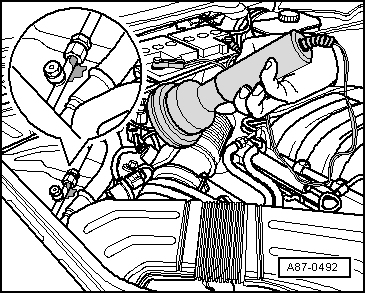
Note
- The leak detection additive can remain in the refrigerant circuit.
- Remove existing leak detection additive in the engine compartment or from the refrigerant circuit components using Leak Detection Kit - Cleaning Solution -VAS6201/3-.
 A/C Service Station, Working with
A/C Service Station, Working with
Important Information when Working with the A/C Service Station
Caution
If it is suspected that chemicals were added to the refrigerant circuit
to seal leaks, do not connect the A/C service statio ...
See More:
Volkswagen Tiguan Service and Repair Manual > Glass, Window regulators: Flush Bonded Windows
Tools
Note
The Cutting Tool for Bonded Windows -VAS6452- can be used instead of the
Flush Bonded Window Kit - VAG1474 A-.
Special tools and workshop equipment required
Flush Bonded Window Kit -VAG1474B-
Double Suction Lifter -VAG1344-
Bonded Window Tool Kit -VAG1351-
Window Removing Kit -VAG17 ...
Volkswagen Tiguan Owners Manual
Volkswagen Tiguan Service and Repair Manual
- Body exterior
- Body Interior
- General Paint Information
- Paint
- Brake System
- Suspension, Wheels, Steering
- Wheel and Tire Guide
- Towing Guide
- Wheel and Tire Guide General Information
- Communication
- Electrical Equipment General Information
- Electrical Equipment from 06/2011
- Heating, Ventilation and Air Conditioning
- Refrigerant R134a Servicing
- 6-Speed Manual Transmission 02Q, OBB, and OFB

